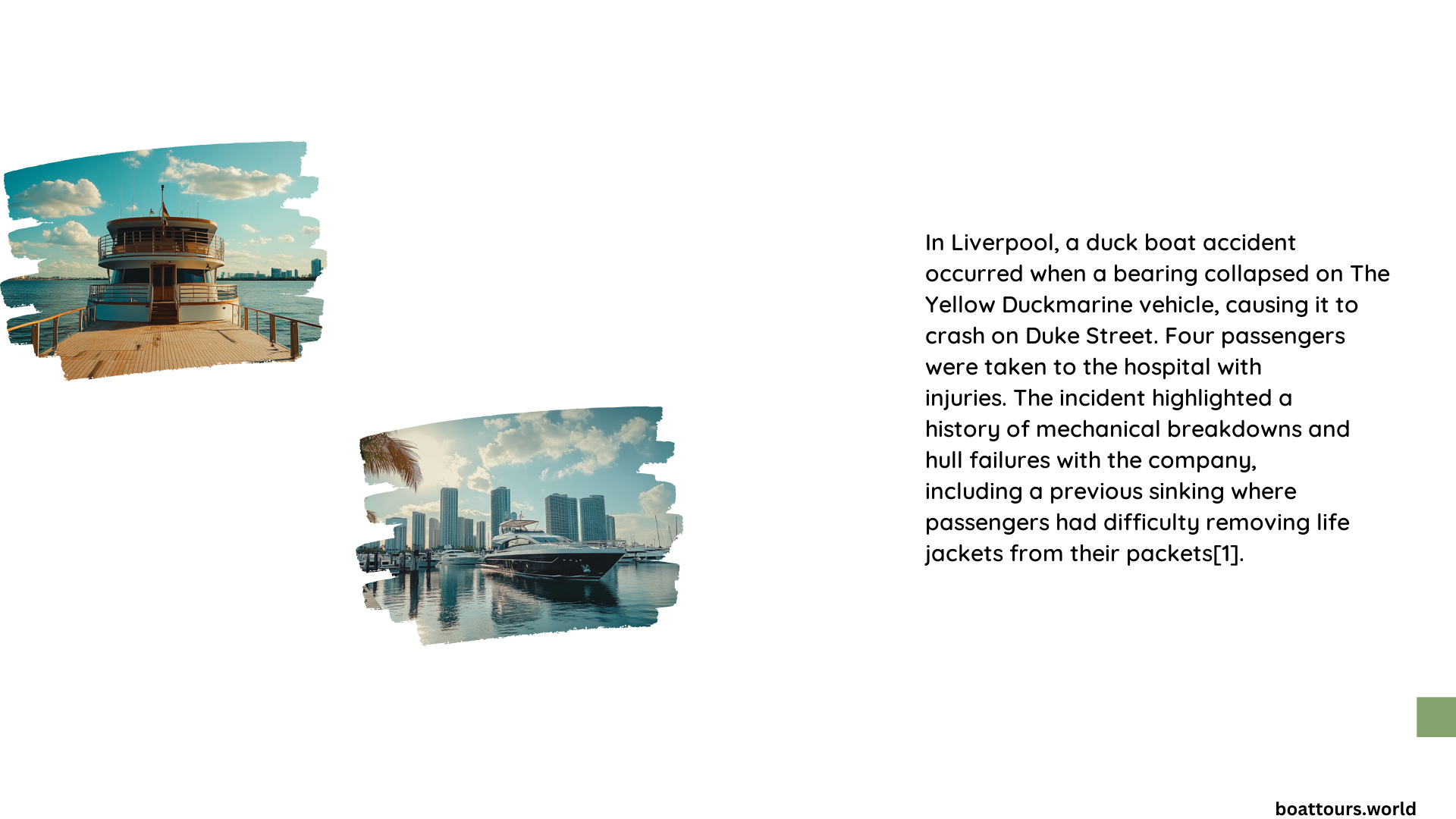The duck boat accidents in Liverpool, occurring in March and June 2013, involved amphibious tour vehicles operated by The Yellow Duckmarine. These incidents resulted in vehicle sinkings, passenger evacuations, and minor injuries. The accidents highlighted significant safety concerns, leading to investigations, withdrawal of safety certificates, and the eventual closure of the operating company. The incidents sparked discussions about the safety of amphibious tour vehicles and the need for stricter regulations in the tourism industry.
What Happened During the Liverpool Duck Boat Accidents?
The Liverpool duck boat accidents refer to two separate incidents that occurred in 2013:
- March 30, 2013 Incident:
- A duck boat sank in Salthouse Dock during a tour.
- All passengers were safely evacuated to a pontoon before the vehicle submerged.
-
No fatalities or serious injuries were reported.
-
June 15, 2013 Incident:
- Another duck boat sank in Albert Dock at the end of a tour.
- 31 people were on board, including children.
- Passengers had to jump into the water as the vehicle rapidly took on water.
- 27 people were treated in hospital for minor injuries.
What Were the Causes of the Duck Boat Accidents?

Investigations into the Liverpool duck boat accidents revealed several contributing factors:
- Poor Maintenance:
- The vehicles had a history of mechanical breakdowns and hull failures.
-
Hulls were found to be heavily corroded.
-
Substandard Repairs:
- Unapproved and inadequate repairs were made to the vehicles.
-
These repairs compromised the seaworthiness of the boats.
-
Inadequate Safety Measures:
- Life jackets were difficult to access during emergencies.
-
Safety protocols were not properly implemented or followed.
-
Lack of Proper Oversight:
- Regular safety inspections failed to identify critical issues.
- The operating company’s safety practices were inadequate.
What Were the Consequences of the Duck Boat Accidents?
The Liverpool duck boat accidents had significant repercussions:
- Immediate Aftermath:
- Passenger injuries and trauma
-
Emergency rescue operations
-
Regulatory Actions:
- The Maritime and Coastguard Agency withdrew all safety certificates for the craft owned by Pearlwild (The Yellow Duckmarine’s parent company).
-
Investigations were launched by multiple agencies.
-
Company Closure:
- The Yellow Duckmarine entered administration.
-
All duck boat tours in Liverpool were suspended indefinitely.
-
Industry-wide Impact:
- Increased scrutiny of amphibious tour vehicles globally
- Calls for stricter safety regulations in the tourism industry
How Did the Accidents Affect Safety Regulations?
The Liverpool duck boat accidents led to several changes in safety regulations and practices:
- Stricter Enforcement:
- More rigorous safety inspections for amphibious vehicles
-
Enhanced maintenance requirements
-
Improved Safety Equipment:
- Emphasis on easily accessible life jackets
-
Better emergency evacuation procedures
-
Operator Accountability:
- Increased scrutiny of tour operators’ safety records
-
More stringent licensing requirements
-
Public Awareness:
- Greater emphasis on passenger safety briefings
- Increased public awareness of potential risks associated with amphibious tours
What Lessons Can Be Learned from the Liverpool Duck Boat Accidents?
The incidents in Liverpool offer several important lessons:
- Maintenance is Crucial:
- Regular, thorough maintenance of amphibious vehicles is essential for safety.
-
Corrosion and wear must be addressed promptly and properly.
-
Safety Equipment Must Be Accessible:
- Life jackets and other safety equipment should be easily accessible in emergencies.
-
Passengers should be properly briefed on safety procedures.
-
Regulatory Oversight is Necessary:
- Regular, stringent safety inspections by qualified authorities are vital.
-
Tour operators must be held to high safety standards.
-
Emergency Preparedness is Key:
- Staff should be well-trained in emergency procedures.
-
Quick response and evacuation plans must be in place and practiced.
-
Public Safety Over Profit:
- Tour operators must prioritize passenger safety over financial considerations.
- Cutting corners on maintenance or safety measures can have severe consequences.
How Have Duck Boat Tours Changed Since the Liverpool Accidents?
The Liverpool accidents, along with other incidents worldwide, have led to significant changes in the duck boat tour industry:
- Increased Regulation:
- Many jurisdictions have implemented stricter safety regulations for amphibious vehicles.
-
Some areas have banned duck boat tours altogether.
-
Improved Vehicle Design:
- Some operators have switched to newer, purpose-built amphibious vehicles with enhanced safety features.
-
Greater emphasis on hull integrity and flotation capabilities.
-
Enhanced Safety Protocols:
- More comprehensive safety briefings for passengers
-
Improved staff training on emergency procedures
-
Public Perception:
- Increased awareness of potential risks associated with duck boat tours
- Greater scrutiny from the public and media on tour operators’ safety records
Conclusion
The duck boat accidents in Liverpool serve as a stark reminder of the importance of safety in the tourism industry. These incidents highlighted the need for rigorous maintenance, proper safety equipment, and stringent regulatory oversight. While the accidents led to the closure of The Yellow Duckmarine, they also sparked important conversations about safety in amphibious tours worldwide. The lessons learned from these incidents continue to shape safety practices and regulations in the industry, ultimately working towards preventing similar tragedies in the future.
References:
1. Wikipedia – Duck tour
2. Injury Trial Lawyer Blog – A History of Duck Boat Crashes and Malfunctions
